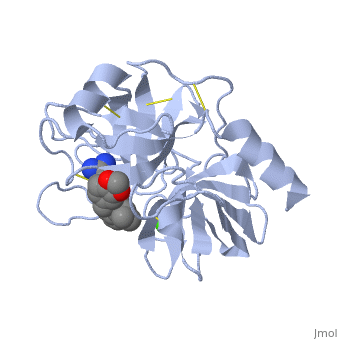Lotem haleva/test page
From Proteopedia
(Difference between revisions)
| Line 12: | Line 12: | ||
== Function == | == Function == | ||
In the duodenum, trypsin catalyzes the hydrolysis of peptide bonds, breaking down proteins into smaller peptides. | In the duodenum, trypsin catalyzes the hydrolysis of peptide bonds, breaking down proteins into smaller peptides. | ||
| + | Trypsin contains <scene name='60/607865/Helix/1'>alpha helix</scene> and beta sheets. | ||
| + | |||
| + | |||
| + | == Mechanism == | ||
The enzymatic mechanism is similar to that of other serine proteases. These enzymes contain a catalytic triad consisting of <scene name='60/607865/Active_site/2'>histidine-57, aspartate-102, and serine-195</scene>. These three residues form a charge relay that serves to make the active site serine nucleophilic. | The enzymatic mechanism is similar to that of other serine proteases. These enzymes contain a catalytic triad consisting of <scene name='60/607865/Active_site/2'>histidine-57, aspartate-102, and serine-195</scene>. These three residues form a charge relay that serves to make the active site serine nucleophilic. | ||
| Line 17: | Line 21: | ||
Trypsin contains an "oxyanion hole" formed by the backbone amide hydrogen atoms of <scene name='60/607865/Oxyanion_hole/1'>Gly-193 and Ser-195</scene> , which serves to stabilize the developing negative charge on the carbonyl oxygen atom of the cleaved amides. | Trypsin contains an "oxyanion hole" formed by the backbone amide hydrogen atoms of <scene name='60/607865/Oxyanion_hole/1'>Gly-193 and Ser-195</scene> , which serves to stabilize the developing negative charge on the carbonyl oxygen atom of the cleaved amides. | ||
The <scene name='60/607865/Asp_189/1'>aspartate residue</scene> located in the catalytic pocket (S1) of trypsin is responsible for attracting and stabilizing positively charged lysine and/or arginine, and is, thus, responsible for the specificity of the enzyme. | The <scene name='60/607865/Asp_189/1'>aspartate residue</scene> located in the catalytic pocket (S1) of trypsin is responsible for attracting and stabilizing positively charged lysine and/or arginine, and is, thus, responsible for the specificity of the enzyme. | ||
| - | == Mechanism == | ||
| - | |||
== Relevance == | == Relevance == | ||
Revision as of 10:20, 23 November 2014
Your Heading Here (maybe something like 'Structure')
| |||||||||||
References
- ↑ Rawlings ND, Barrett AJ. Families of serine peptidases. Methods Enzymol. 1994;244:19-61. doi: 10.1016/0076-6879(94)44004-2. PMID:7845208 doi:http://dx.doi.org/10.1016/0076-6879(94)44004-2

